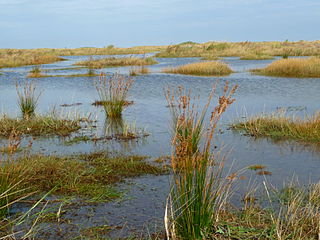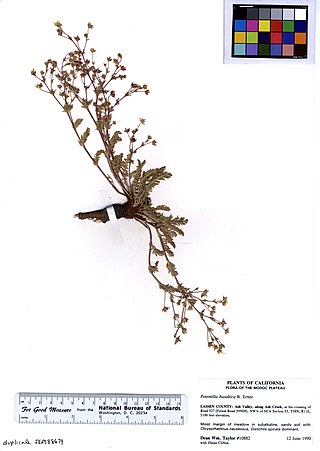
Lotus, a latinization of Greek lōtos, is a genus of flowering plants that includes most bird's-foot trefoils and deervetches and contains many dozens of species distributed in the eastern hemisphere, including Africa, Europe, western, southern, and eastern Asia, and Australia and New Guinea. Depending on the taxonomic authority, roughly between 70 and 150 are accepted. Lotus is a genus of legumes and its members are adapted to a wide range of habitats, from coastal environments to high elevations.

The dingy skipper is a species of butterfly in the family Hesperiidae.

Sporobolus maritimus, or synonymously as Spartina maritima, the small cordgrass, is a species of cordgrass native to the coasts of western and southern Europe and western Africa, from the Netherlands west across southern England to southern Ireland, and south along the Atlantic coast to Morocco and also on the Mediterranean Sea coasts. There is also a disjunct population on the Atlantic coasts of Namibia and South Africa.
British NVC community MC5 is one of the maritime cliff communities in the British National Vegetation Classification system. It is one of five communities categorised as maritime cliff crevice and ledge communities.

Rumex maritimus, commonly called golden dock, bristle dock, or seashore dock, is an annual plant species of the genus Rumex. Rumex D maritimus grows in Argentina, Burma, Canada, China, and the United States. It is native to Canada and most of the 48 states. The life span of Rumex maritimus is rarely biennial in moist environments. This herb belongs to the family Polygonaceae.
L. maritimus may refer to:

Acmispon maritimus, synonym Lotus salsuginosus, is a species of legume native to Arizona, California and northwestern Mexico. It is known by the common name coastal bird's-foot trefoil. It grows in many types of mountain, desert, and scrub habitat, not necessarily near the coast. It is an annual herb quite variable in morphology, from petite to bushy, hairless to roughly hairy, and prostrate to erect in form. The slender stems are lined with leaves each made up of pairs of leaflets variable in shape and size. The inflorescence is a small array of 1 to 4 yellow flowers, each up to a centimeter long or so. The elongated flower corolla emerges from a tubular calyx of sepals. The fruit is a legume pod up to 3 centimeters long. Laboratory studies have shown this species, which occurs in wildfire-prone habitat such as chaparral, to have an increased rate of seed germination after exposure to heat.

Tijuana Slough National Wildlife Refuge is a wildlife refuge in the most southwestern corner of the contiguous United States. As a National Wildlife Refuge, it is administered by the U.S. Fish and Wildlife Service. It was established in 1980.

Bromus maritimus is a species of brome grass known by the common names maritime brome and seaside brome. It is native to the coastal areas of California and Oregon.

Bolboschoenus maritimus is a species of flowering plant from family Cyperaceae. Common names for this species include sea clubrush, cosmopolitan bulrush, alkali bulrush, saltmarsh bulrush, and bayonet grass. It is found in seaside wetland habitats over much of the world. It is widespread across much of temperate and subtropical Africa, Asia, Europe, North America, South America and various islands.

Bolboschoenus robustus is a species of flowering plant in the sedge family. It is known by many common names: saltmarsh bulrush, alkali bulrush, sturdy bulrush, seacoast bulrush, stout bulrush, three-cornered sedge or leafy three-cornered sedge, and seaside club-rush.
Trifurcula eurema is a moth of the family Nepticulidae. It is widespread throughout Europe, northwards to southern Norway and Sweden, Poland and the Baltic Region. It is also found in the Mediterranean region, including the larger Mediterranean islands, east to Bulgaria, Asiatic Turkey and Ukraine.

Bembecia ichneumoniformis, the six-belted clearwing, is a moth of the family Sesiidae.
Leucoptera lotella is a moth in the Lyonetiidae family. It is found from Denmark to Portugal, Italy and Croatia, and from Great Britain to Poland and Hungary.

Acmispon is a genus of flowering plant in the family Fabaceae (legumes), native to North America and the west coast of Chile in South America. It includes several species of American bird's-foot trefoils and deervetches formerly contained in the globally distributed genus Lotus. The former genus Syrmatium is included in Acmispon. The Jepson eFlora accepts only Acmispon.

Gymnopilus maritimus is a fungus species of the family Hymenogastraceae first collected in northern Sardinia, Italy, in 2006. The species produces moderately sized, sturdy mushrooms of a reddish-orange colour. The cap, which can measure up to 70 millimetres (3 in) across, is covered in orange fibrils, and sometimes has small scales. The yellowish stem measures up to 110 mm (4 in) in length by 8 mm (0.3 in) in width, and sometimes shows remnants of the partial veil. The mushrooms have thick gills of a variable colour, ranging from yellow to rust but staining darker, and the yellow flesh has a mild taste. The mushrooms leave a rusty-brown spore print, while the spores themselves measure from 7.5–11.5 micrometres (0.00030–0.00045 in) in length. The species is most similar in appearance to G. arenophilus and G. fulgens, but can be differentiated from both morphologically. Despite the similarities, it is not closely related to either, suggesting convergent evolution. Instead, within the genus Gymnopilus, it is most closely related to the spectabilis–imperialis clade. However, it is not particularly similar to any of its closest relatives.

Juncus maritimus, known as the sea rush, is a species of rush that grows on coastlines. It is sometimes considered conspecific with Juncus kraussii. It has a wide distribution across the western Palearctic realm.

Coleophora colutella is a moth of the family Coleophoridae. It is found in all of Europe, except Great Britain and Ireland. It is an introduced species in North America.

Pima boisduvaliella is a species of snout moth. It is found in most of Europe, Asia, including Mongolia and Kazakhstan and northern North America, including Alberta.

Potentilla basaltica is a species of flowering plant in the rose family known by the common names Soldier Meadows cinquefoil and basalt cinquefoil. It is endemic to a small area of the Modoc Plateau and Warner Mountains in northeastern California and northwestern Nevada.
















